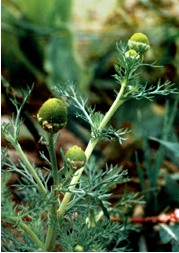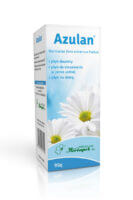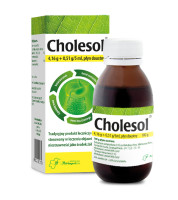(Chamomilla recutita L.)
Chamomile is a herbaceous plant of the Asteraceae family. It occurs commonly in meadows, wastelands, and is also cultivated for pharmaceutical and cosmetic industry. Its name, chamomilla, derives from the Greek language and originates from the words chamos– land and melos– apple. It refers to a very characteristic smell of the plant. The Latin name of chamomile – matricaria means mother, and has been given to the plant, because of the soothing “maternal” characteristics. Chamomile is one of the oldest and most popular medicinal herbs. Already the physician and botanist of Roman legionnaires – Dioscorides, recommended it to relieve abdominal pain and as an anti-inflammatory drug 1,2,3.
Chamomile basket, consisting of two types of flowers, is used in medicine. The outer are in the form of white flaps, while the inner are yellow tubular flowers. The raw material is collected at the beginning of flowering and thoroughly dried after harvest. It contains flavonoids, coumarins and mucous compounds. An essential oil is also obtained from fresh chamomile baskets, which due to its content of azulenes has an intense blue color. The extract from the dried raw material has various effects and can be used both, in the form of internal preparations as well as those for external use. It demonstrates anti-inflammatory and disinfecting activity and has a relaxant effect on smooth muscle 2,3,4. This is confirmed by the results of clinical trials carried out by scientists and doctors. In one of them they proved that flavonoids contained by chamomile (such as apigenin and luteolin) are not only adsorbed on the surface of the skin, but also penetrate into the deeper layers, which is important in the treatment of inflammatory conditions 5.
Chamomile has been also applied in cosmetics. It is an addition to the creams, lotions, bubble baths and masks for skin care. Herbapol Wrocław used the extract of dried inflorescences of the plants in the recipe of a few preparations. Chamomile extract is a component of oral liquids Azulan and Cholesol, skin fluid Azucalen and Hemorol suppositories.
1 A. Grys, M. Kania, J. Baraniak, Rumianek – pospolita roślina zielarska o różnorodnych właściwościach biologicznych i leczniczych, Postępy Fitoterapii 2/2014, s. 90-93
2 P. Ody, Wielki zielnik medyczny, wyd. DEBIT, s. 47
3 H. Strzelecka, J. Kowalski, Encyklopedia Zielarstwa i Ziołolecznictwa, Wydawnictwo Naukowe PWN, Warszawa 2000, s. 493
4 M. Zielińska-Pisklak, Ł. Szeleszczuk, Rumianek lekarski– dlaczego warto mieć go w domowej apteczce, Lek w Polsce, 9/2013, s. 72-79
5 I. Merfort, J. Heilmann, U. Hagedorn-Leweke, B.C. Lippold, In vivo skin penetration studies of camomile flavones, Pharmazie; 1994; 49(7):509-11




